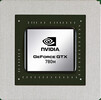Review Alienware 17 (Haswell) Notebook
Intel Core i7-4800MQ | NVIDIA GeForce GTX 780M | 17.30" | 4.2 kg

The NVIDIA GeForce GTX 780M is a high-end DirectX 11-compatible graphics card for laptops. It is based on the same chip as the GeForce GTX 680MX but offers a higher core clock at a lower TDP. It is based on the 28nm GK104 Kepler architecture similar to the GTX 680M, but features more CUDA cores (1536 vs. 1344), a higher clock rate and GPU Boost 2.0. As of summer 2013, it is the fastest laptop graphics card on the market.
As a novelty, the GeForce 700M series implements GPU Boost 2.0 to automatically overclock the core clock rate. Depending on the cooling headroom of the laptop and the application / game, up to 15 % performance gains are possible.
Architecture
The Kepler architecture is the successor to the Fermi architecture that first appeared in laptops with the GeForce 400M series. The GK104 Kepler core offers eight shader blocks, called SMX, that are clocked at the same speed as the central core. In the GTX 780M, all eight blocks are active for a total of 1536 CUDA cores. Although the Kepler architecture can utilize more shader cores than a Fermi chip, its shaders can be up to twice as power efficient. However, due to the missing hot clock of the shader domain, two shaders of a Kepler chip are of similar speed to one shader of a Fermi chip (as the latter is clocked twice as fast).
PCIe 3.0 is now supported by the mobile Kepler series and an optional Turbo mode can automatically overclock the Nvidia card by a theoretical 15 percent if the laptop cooling system allows it. The implementation of this boost mode is done in the BIOS, but it is ultimately dependent upon the manufacturer of the laptop.
Performance
In our gaming tests the GeForce GTX 780M was able to gain a 30 percent lead to the older Nvidia Geforce GTX 680M thanks to the additional shader cores and higher clock rates. That makes the GTX 780M the fastest single mobile graphics card in summer 2013 and 10 - 15 percent faster than the AMD Radeon HD 8970M. The GPU has enough power to run demanding games of 2012 fluently with Full HD resolution and maxed out graphical settings. Battlefield 3, Skyrim, and Crysis 2, for example, are playable at the highest detail settings (see benchmarks below).
Features
The improved feature set now includes support for up to 4 active displays. Furthermore, high resolution monitors of up to 3840x2160 pixels can now be connected using DisplayPort 1.2 or HDMI 1.4a if available. HD-Audio codecs, such as Dolby TrueHD and DTS-HD, can be transmitted via bitstream mode through the HDMI port. However, as most laptops will feature Optimus, the integrated GPU will likely have direct control over the display ports and may limit the feature set available by the Nvidia Kepler cards.
The 5th generation PureVideo HD video processor (VP5) is also integrated in the GK104 core and offers hardware decoding of HD videos. Common codecs such as MPEG-1/2, MPEG-4 ASP, H.264 and VC1/WMV9 are fully supported up to 4K resolutions while VC1 and MPEG-4 are supported up to 1080p. Two streams can be decoded in parallel for features such as Picture-in-Picture. Another novelty is the inclusion of a dedicated video encoding engine similar to Intel QuickSync that can be accessed by the NVENC API.
The power consumption of the GeForce GTX 780M should be similar or slightly higher than the GTX 680M (100 Watt TDP). According to rumors it should stay below the GTX 680MX in the iMac but still it is best suited for 17-inch desktop replacement laptops.
GeForce GTX 700M Series
| |||||||||||||||||||||||||
| Codename | N14E-GTX | ||||||||||||||||||||||||
| Architecture | Kepler | ||||||||||||||||||||||||
| Pipelines | 1536 - unified | ||||||||||||||||||||||||
| Core Speed | 823 MHz | ||||||||||||||||||||||||
| Memory Speed | 5000 MHz | ||||||||||||||||||||||||
| Memory Bus Width | 256 Bit | ||||||||||||||||||||||||
| Memory Type | GDDR5 | ||||||||||||||||||||||||
| Max. Amount of Memory | 4 GB | ||||||||||||||||||||||||
| Shared Memory | no | ||||||||||||||||||||||||
| API | DirectX 11, Shader 5.0, OpenGL 4.3 | ||||||||||||||||||||||||
| Power Consumption | 100 Watt | ||||||||||||||||||||||||
| Transistor Count | 3.5 Billion | ||||||||||||||||||||||||
| technology | 28 nm | ||||||||||||||||||||||||
| Features | Optimus, SLI, PhysX, Verde Drivers, CUDA, 3D Vision, 3DTV Play | ||||||||||||||||||||||||
| Notebook Size | large | ||||||||||||||||||||||||
| Date of Announcement | 30.05.2013 | ||||||||||||||||||||||||
The following benchmarks stem from our benchmarks of review laptops. The performance depends on the used graphics memory, clock rate, processor, system settings, drivers, and operating systems. So the results don't have to be representative for all laptops with this GPU. For detailed information on the benchmark results, click on the fps number.





















































For more games that might be playable and a list of all games and graphics cards visit our Gaming List
One K56-3N2: Intel Core i7-4700MQ, 15.60", 3.3 kg
Review » Review One K56-3N2 (Clevo P157SM) Notebook
Review » In Review: Nvidia GeForce GTX 780M, GTX 770M & GTX 765M
Asus G750JH-T4180H: Intel Core i7-4700HQ, 17.30", 4.3 kg
External Review » Asus G750JH-T4180H
One K56-3N2: Intel Core i7-4700MQ, 15.60", 3.3 kg
External Review » One K56-3N2
MSI GT70 2OD-679UK: Intel Core i7-4930MX, 17.30", 3.9 kg
External Review » MSI GT70 2OD-679UK
Asus G750JH-T4070H: Intel Core i7-4700HQ, 17.00", 4.8 kg
External Review » Asus G750JH-T4070H
Origin PC EON17-S 2013: Intel Core i7-4930MX, 17.30", 3.9 kg
External Review » Origin PC EON17-S 2013
MSI GT60-2OD-092UK: Intel Core i7-4700MQ, 15.60", 3.5 kg
External Review » MSI GT60-2OD-092UK
Medion Erazer X7827: Intel Core i7-4700MQ, 17.30", 3.8 kg
External Review » Medion Erazer X7827
Asus G750JH-T4080H: Intel Core i7-4700HQ, 17.30", 4.2 kg
External Review » Asus G750JH-T4080H
Alienware 17 (Haswell): Intel Core i7-4800MQ, 17.30", 4.2 kg
External Review » Alienware 17, GTX 780M
Deviltech Devil 7800: Intel Core i7-4700MQ, 15.60", 3.5 kg
External Review » Deviltech Devil 7800
Eurocom X3: Intel Core i7-4930MX, 15.60", 3.5 kg
External Review » Eurocom X3
MSI GT70-2OC-3OC: Intel Core i7-4930MX, 17.00", 4 kg
External Review » MSI GT70-2OC-3OC
MSI GT70 20D-077NE: Intel Core i7-4930MX, 17.30", 3.9 kg
External Review » MSI GT70 20D-077NE
MSI GT60-2OD-026US: Intel Core i7-4800MQ, 15.60", 3.4 kg
External Review » MSI GT60-2OD-026US
Alienware M17x, Haswell: Intel Core i7-4800MQ, 17.30", 4.1 kg
External Review » Alienware M17x, Haswell
MSI GT70-2OD-039US: Intel Core i7-4700MQ, 17.30", 3.9 kg
External Review » MSI GT70-2OD-039US
Cyberpower Fangbook EVO HX7-200: Intel Core i7-4700MQ, 17.30", 3.9 kg
External Review » Cyberpower Fangbook EVO HX7-200
Schenker XMG P703: Intel Core i7-4900MQ, 17.30", 3.9 kg
External Review » Schenker XMG P703
MSI GT70-2OD Dragon Edition 2: Intel Core i7-4930MX, 17.30", 3.9 kg
External Review » MSI GT70-2OD Dragon Edition 2
MSI GT70SR2-x80M43237BW: Intel Core i7-4700MQ, 17.30", 3.9 kg
External Review » MSI GT70SR2-x80M43237BW
» Comparison of GPUs
Detailed list of all laptop GPUs sorted by class and performance.
» Benchmark List
Sort and restrict laptop GPUs based on performance in synthetic benchmarks.
» Notebook Gaming List
Playable games for each graphics card and their average FPS results.
Top 10 Laptops
Multimedia, Budget Multimedia, Gaming, Budget Gaming, Lightweight Gaming, Business, Budget Office, Workstation, Subnotebooks, Ultrabooks, Chromebooks
under 300 USD/Euros, under 500 USD/Euros, 1,000 USD/Euros, for University Students, Best Displays
Top 10 Smartphones
Smartphones, Phablets, ≤6-inch, Camera Smartphones